Chunbo Luo
REOBench: Benchmarking Robustness of Earth Observation Foundation Models
May 22, 2025Abstract:Earth observation foundation models have shown strong generalization across multiple Earth observation tasks, but their robustness under real-world perturbations remains underexplored. To bridge this gap, we introduce REOBench, the first comprehensive benchmark for evaluating the robustness of Earth observation foundation models across six tasks and twelve types of image corruptions, including both appearance-based and geometric perturbations. To ensure realistic and fine-grained evaluation, our benchmark focuses on high-resolution optical remote sensing images, which are widely used in critical applications such as urban planning and disaster response. We conduct a systematic evaluation of a broad range of models trained using masked image modeling, contrastive learning, and vision-language pre-training paradigms. Our results reveal that (1) existing Earth observation foundation models experience significant performance degradation when exposed to input corruptions. (2) The severity of degradation varies across tasks, model architectures, backbone sizes, and types of corruption, with performance drop varying from less than 1% to over 20%. (3) Vision-language models show enhanced robustness, particularly in multimodal tasks. REOBench underscores the vulnerability of current Earth observation foundation models to real-world corruptions and provides actionable insights for developing more robust and reliable models.
Gaze Into the Abyss -- Planning to Seek Entropy When Reward is Scarce
May 22, 2025Abstract:Model-based reinforcement learning (MBRL) offers an intuitive way to increase the sample efficiency of model-free RL methods by simultaneously training a world model that learns to predict the future. MBRL methods have progressed by largely prioritising the actor; optimising the world model learning has been neglected meanwhile. Improving the fidelity of the world model and reducing its time to convergence can yield significant downstream benefits, one of which is improving the ensuing performance of any actor it may train. We propose a novel approach that anticipates and actively seeks out high-entropy states using short-horizon latent predictions generated by the world model, offering a principled alternative to traditional curiosity-driven methods that chase once-novel states well after they were stumbled into. While many model predictive control (MPC) based methods offer similar alternatives, they typically lack commitment, synthesising multi step plans after every step. To mitigate this, we present a hierarchical planner that dynamically decides when to replan, planning horizon length, and the weighting between reward and entropy. While our method can theoretically be applied to any model that trains its own actors with solely model generated data, we have applied it to just Dreamer as a proof of concept. Our method finishes the Miniworld procedurally generated mazes 50% faster than base Dreamer at convergence and the policy trained in imagination converges in only 60% of the environment steps that base Dreamer needs.
AE-DENet: Enhancement for Deep Learning-based Channel Estimation in OFDM Systems
Nov 13, 2024Abstract:Deep learning (DL)-based methods have demonstrated remarkable achievements in addressing orthogonal frequency division multiplexing (OFDM) channel estimation challenges. However, existing DL-based methods mainly rely on separate real and imaginary inputs while ignoring the inherent correlation between the two streams, such as amplitude and phase information that are fundamental in communication signal processing. This paper proposes AE-DENet, a novel autoencoder(AE)-based data enhancement network to improve the performance of existing DL-based channel estimation methods. AE-DENet focuses on enriching the classic least square (LS) estimation input commonly used in DL-based methods by employing a learning-based data enhancement method, which extracts interaction features from the real and imaginary components and fuses them with the original real/imaginary streams to generate an enhanced input for better channel inference. Experimental findings in terms of the mean square error (MSE) results demonstrate that the proposed method enhances the performance of all state-of-the-art DL-based channel estimators with negligible added complexity. Furthermore, the proposed approach is shown to be robust to channel variations and high user mobility.
Robust Multimodal Learning via Representation Decoupling
Jul 05, 2024Abstract:Multimodal learning robust to missing modality has attracted increasing attention due to its practicality. Existing methods tend to address it by learning a common subspace representation for different modality combinations. However, we reveal that they are sub-optimal due to their implicit constraint on intra-class representation. Specifically, the sample with different modalities within the same class will be forced to learn representations in the same direction. This hinders the model from capturing modality-specific information, resulting in insufficient learning. To this end, we propose a novel Decoupled Multimodal Representation Network (DMRNet) to assist robust multimodal learning. Specifically, DMRNet models the input from different modality combinations as a probabilistic distribution instead of a fixed point in the latent space, and samples embeddings from the distribution for the prediction module to calculate the task loss. As a result, the direction constraint from the loss minimization is blocked by the sampled representation. This relaxes the constraint on the inference representation and enables the model to capture the specific information for different modality combinations. Furthermore, we introduce a hard combination regularizer to prevent DMRNet from unbalanced training by guiding it to pay more attention to hard modality combinations. Finally, extensive experiments on multimodal classification and segmentation tasks demonstrate that the proposed DMRNet outperforms the state-of-the-art significantly.
Intelligent Reflecting Surfaces vs. Full-Duplex Relays: A Comparison in the Air
Mar 14, 2024Abstract:This letter aims to provide a fundamental analytical comparison for the two major types of relaying methods: intelligent reflecting surfaces and full-duplex relays, particularly focusing on unmanned aerial vehicle communication scenarios. Both amplify-and-forward and decode-and-forward relaying schemes are included in the comparison. In addition, optimal 3D UAV deployment and minimum transmit power under the quality of service constraint are derived. Our numerical results show that IRSs of medium size exhibit comparable performance to AF relays, meanwhile outperforming DF relays under extremely large surface size and high data rates.
One-stage Modality Distillation for Incomplete Multimodal Learning
Sep 15, 2023



Abstract:Learning based on multimodal data has attracted increasing interest recently. While a variety of sensory modalities can be collected for training, not all of them are always available in development scenarios, which raises the challenge to infer with incomplete modality. To address this issue, this paper presents a one-stage modality distillation framework that unifies the privileged knowledge transfer and modality information fusion into a single optimization procedure via multi-task learning. Compared with the conventional modality distillation that performs them independently, this helps to capture the valuable representation that can assist the final model inference directly. Specifically, we propose the joint adaptation network for the modality transfer task to preserve the privileged information. This addresses the representation heterogeneity caused by input discrepancy via the joint distribution adaptation. Then, we introduce the cross translation network for the modality fusion task to aggregate the restored and available modality features. It leverages the parameters-sharing strategy to capture the cross-modal cues explicitly. Extensive experiments on RGB-D classification and segmentation tasks demonstrate the proposed multimodal inheritance framework can overcome the problem of incomplete modality input in various scenes and achieve state-of-the-art performance.
MMANet: Margin-aware Distillation and Modality-aware Regularization for Incomplete Multimodal Learning
Apr 17, 2023



Abstract:Multimodal learning has shown great potentials in numerous scenes and attracts increasing interest recently. However, it often encounters the problem of missing modality data and thus suffers severe performance degradation in practice. To this end, we propose a general framework called MMANet to assist incomplete multimodal learning. It consists of three components: the deployment network used for inference, the teacher network transferring comprehensive multimodal information to the deployment network, and the regularization network guiding the deployment network to balance weak modality combinations. Specifically, we propose a novel margin-aware distillation (MAD) to assist the information transfer by weighing the sample contribution with the classification uncertainty. This encourages the deployment network to focus on the samples near decision boundaries and acquire the refined inter-class margin. Besides, we design a modality-aware regularization (MAR) algorithm to mine the weak modality combinations and guide the regularization network to calculate prediction loss for them. This forces the deployment network to improve its representation ability for the weak modality combinations adaptively. Finally, extensive experiments on multimodal classification and segmentation tasks demonstrate that our MMANet outperforms the state-of-the-art significantly. Code is available at: https://github.com/shicaiwei123/MMANet
Behavioural Reports of Multi-Stage Malware
Jan 30, 2023



Abstract:The extensive damage caused by malware requires anti-malware systems to be constantly improved to prevent new threats. The current trend in malware detection is to employ machine learning models to aid in the classification process. We propose a new dataset with the objective of improving current anti-malware systems. The focus of this dataset is to improve host based intrusion detection systems by providing API call sequences for thousands of malware samples executed in Windows 10 virtual machines. A tutorial on how to create and expand this dataset is provided along with a benchmark demonstrating how to use this dataset to classify malware. The data contains long sequences of API calls for each sample, and in order to create models that can be deployed in resource constrained devices, three feature selection methods were tested. The principal innovation, however, lies in the multi-label classification system in which one sequence of APIs can be tagged with multiple labels describing its malicious behaviours.
Deep Learning Based Automatic Modulation Recognition: Models, Datasets, and Challenges
Jul 20, 2022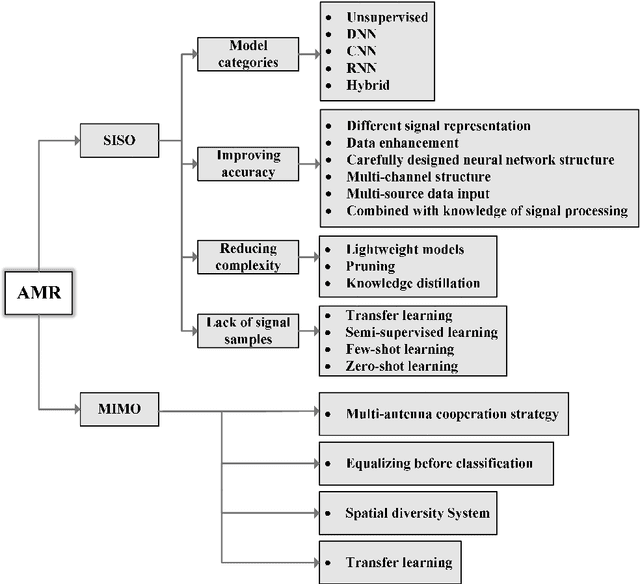
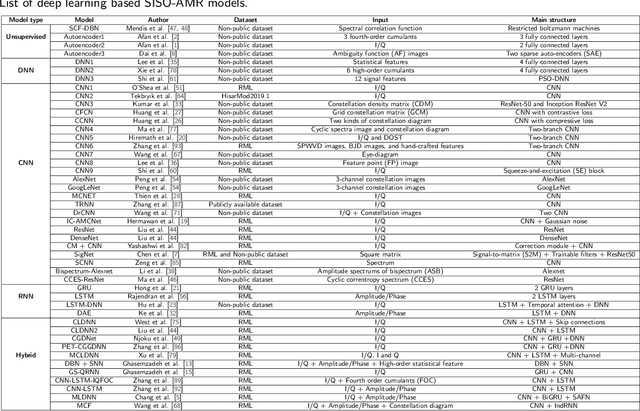
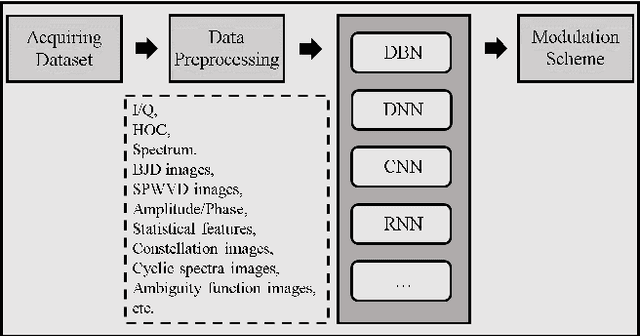

Abstract:Automatic modulation recognition (AMR) detects the modulation scheme of the received signals for further signal processing without needing prior information, and provides the essential function when such information is missing. Recent breakthroughs in deep learning (DL) have laid the foundation for developing high-performance DL-AMR approaches for communications systems. Comparing with traditional modulation detection methods, DL-AMR approaches have achieved promising performance including high recognition accuracy and low false alarms due to the strong feature extraction and classification abilities of deep neural networks. Despite the promising potential, DL-AMR approaches also bring concerns to complexity and explainability, which affect the practical deployment in wireless communications systems. This paper aims to present a review of the current DL-AMR research, with a focus on appropriate DL models and benchmark datasets. We further provide comprehensive experiments to compare the state of the art models for single-input-single-output (SISO) systems from both accuracy and complexity perspectives, and propose to apply DL-AMR in the new multiple-input-multiple-output (MIMO) scenario with precoding. Finally, existing challenges and possible future research directions are discussed.
DynPL-SVO: A New Method Using Point and Line Features for Stereo Visual Odometry in Dynamic Scenes
May 17, 2022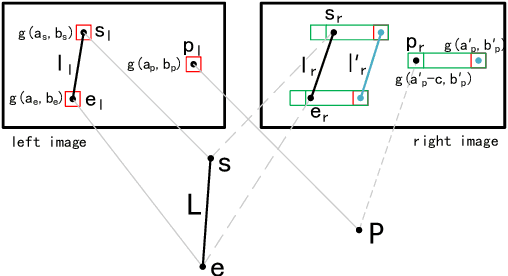
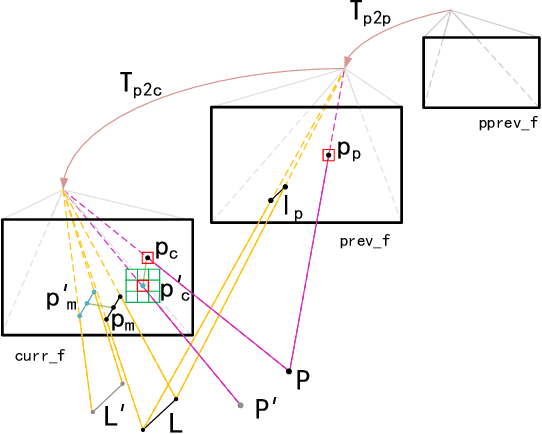
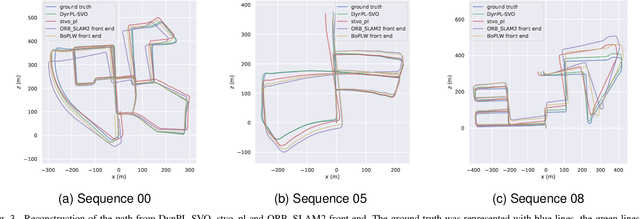

Abstract:Stereo visual odometry is widely used where a robot tracks its position and orientation using stereo cameras. Most of the approaches recovered mobile robotics motion based on the matching and tracking of point features along a sequence of stereo images. But in low-textured and dynamic scenes, there are no sufficient robust static point features for motion estimation, causing lots of previous work to fail to reconstruct the robotic motion. However, line features can be detected in such low-textured and dynamic scenes. In this paper, we proposed DynPL-SVO, a stereo visual odometry with the $dynamic$ $grid$ algorithm and the cost function containing both vertical and horizontal information of the line features. Stereo camera motion was obtained through Levenberg-Marquard minimization of re-projection error of point and line features. The experimental results on the KITTI and EuRoC MAV datasets showed that the DynPL-SVO had a competitive performance when compared to other state-of-the-art systems by producing more robust and accurate motion estimation, especially in low-textured and dynamic scenes.
 Add to Chrome
Add to Chrome Add to Firefox
Add to Firefox Add to Edge
Add to Edge